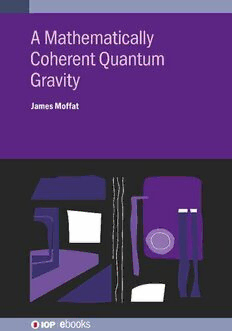Table Of ContentA Mathematically Coherent
Quantum Gravity
A Mathematically Coherent
Quantum Gravity
James Moffat
Kings College, University of Aberdeen, Aberdeen, UK
IOP Publishing, Bristol, UK
ªIOPPublishingLtd2020
Allrightsreserved.Nopartofthispublicationmaybereproduced,storedinaretrievalsystem
ortransmittedinanyformorbyanymeans,electronic,mechanical,photocopying,recording
orotherwise,withoutthepriorpermissionofthepublisher,orasexpresslypermittedbylawor
undertermsagreedwiththeappropriaterightsorganization.Multiplecopyingispermittedin
accordancewiththetermsoflicencesissuedbytheCopyrightLicensingAgency,theCopyright
ClearanceCentreandotherreproductionrightsorganizations.
PermissiontomakeuseofIOPPublishingcontentotherthanassetoutabovemaybesought
[email protected].
JamesMoffathasassertedhisrighttobeidentifiedastheauthorofthisworkinaccordancewith
sections77and78oftheCopyright,DesignsandPatentsAct1988.
ISBN 978-0-7503-2580-6(ebook)
ISBN 978-0-7503-2578-3(print)
ISBN 978-0-7503-2581-3(myPrint)
ISBN 978-0-7503-2579-0(mobi)
DOI 10.1088/978-0-7503-2580-6
Version:20200901
IOPebooks
BritishLibraryCataloguing-in-PublicationData:Acataloguerecordforthisbookisavailable
fromtheBritishLibrary.
PublishedbyIOPPublishing,whollyownedbyTheInstituteofPhysics,London
IOPPublishing,TempleCircus,TempleWay,Bristol,BS16HG,UK
USOffice:IOPPublishing,Inc.,190NorthIndependenceMallWest,Suite601,Philadelphia,
PA19106,USA
Thecoverdesignisbasedonapaintingbytheauthor.Itiscalled‘Logos’whichisGreekforLogic.
I dedicate this book jointly to Frank Bonsall and John Ringrose.
Contents
Preface: why you should read this book x
Acknowledgements xiii
Author biography xiv
Symbols xv
1 Quantum theory 1-1
1.1 Basic notions 1-1
1.2 Non-relativistic quantum theory 1-2
1.2.1 The measurement process 1-4
1.2.2 The Schrödinger equation 1-5
1.3 Exploiting quantum theory embedded in classical gravity 1-6
1.4 Special relativity 1-9
1.4.1 Relativistic waves 1-10
1.4.2 Jones vectors to describe classical polarization states 1-11
1.4.3 The relativistic quantum photon 1-12
1.5 Dirac relativistic spinor theory 1-14
1.5.1 The relativistic spinor 1-15
1.6 von Neumann algebras 1-17
1.7 A higher level of abstraction: quantum W*-algebras 1-19
1.8 A brief comparison with the approach of Rovelli and Penrose 1-20
References 1-21
2 Computational spin networks and quantum paths in space–time 2-1
2.1 Introduction 2-1
2.2 The measurement of space and time 2-2
2.3 Computational spin networks 2-5
2.4 The homology invariants of space–time 2-7
2.5 Quantum paths in space–time 2-10
2.5.1 Fiber bundle structure of classical phase space 2-11
2.5.2 An example of the Weyl form 2-12
2.6 Fractal paths in classical space–time 2-16
2.7 Supersymmetry and the spinor calculus 2-17
2.7.1 2-Spinors 2-17
2.7.2 4-Spinors and the Lorentz and Poincaré groups 2-19
2.7.3 4-Spinors and the spin groups 2-21
vii
AMathematicallyCoherentQuantumGravity
2.8 Irreducible representations of the Poincaré Lie algebra 2-22
2.8.1 The supersymmetric extension of the standard model (SSM) 2-22
2.9 Dirac spinors and the spinor calculus 2-23
2.9.1 The supersymmetry algebra 2-25
References 2-26
3 Particles in algebraic quantum gravity 3-1
3.1 Introduction 3-1
3.2 Lie groups, fibre bundles and quantum fields in loop quantum gravity 3-1
3.2.1 A coherent approach to quantum fields 3-3
3.3 A remarkable theorem 3-4
3.4 Properties of the projection onto the base space B of a Stonean 3-6
fibre bundle K
3.4.1 Lifting from the base space 3-6
3.5 Quantum connections 3-7
3.6 The supersymmetric extension of the standard model 3-8
3.7 Factorial representations of the graded Lie algebra 3-11
3.8 Does supersymmetry exist? ATLAS results for Run 2 of 3-13
the LHC at 13 TeV
3.9 Adding fermions and bosons to the mix 3-15
3.10 The 10-dimensional pure gravity action 3-16
3.11 Adding bosons to the theory 3-17
3.12 Adding fermions 3-17
3.13 Symmetry breaking to create mass 3-19
References 3-21
4 The algebraic nature of reality 4-1
4.1 Introduction 4-1
4.2 Symmetry invariance and symmetry breaking in Yang–Mills 4-2
quantum fields
4.2.1 Wigner sets and symmetry invariance in the local algebra O(D) 4-2
4.2.2 Symmetric Yang–Mills quantum states 4-4
4.2.3 Superspace 4-5
4.3 The structure of local algebras of Yang–Mills quantum fields 4-8
4.4 Developing a diffeomorphism invariant theory for quantum states 4-9
4.4.1 Wandering projections and diffeomorphism invariant quantum 4-11
states
viii
AMathematicallyCoherentQuantumGravity
4.5 The information dynamics of black holes 4-13
4.6 Summary of chapter 4 4-15
Further reading 4-16
References 4-16
5 Implications 5-1
5.1 Implications for mathematics 5-1
5.1.1 Clay Mathematics Institute Millennial question: Yang–Mills 5-1
quantum theory and the mass gap
5.2 Further implications for Physics 5-4
5.2.1 Discrete closed strings in the early Universe 5-4
5.2.2 The continuum limit beyond the Planck regime 5-7
5.2.3 The continuum limit as a quantum field 5-7
5.2.4 A brief non-technical overview 5-10
References 5-11
ix

